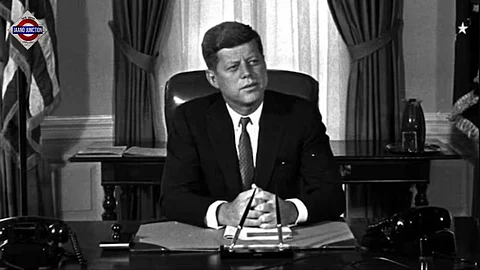

The Donald Trump administration on Wednesday released the previously classified documents and files related to the assassination of former President John F Kennedy in 1963 – a case that still fuels conspiracy theories more than 60 years after his death.
The move follows an executive order issued by Trump in January directing the unredacted release of the remaining files related to the assassinations of Kennedy, his brother, former Attorney General Robert F Kennedy, and civil rights leader Martin Luther King Jr, to provide more transparency about the incident in Texas.
The National Archives has released millions of pages of records over the past decades relating to the assassination of then-President Kennedy in November 1963, however, thousands of documents had been held back at the request of the Central Intelligence Agency (CIA) and Federal Bureau of Investigation (FBI), citing national security concerns.
The 1,123 files were posted on the website of the US National Archives and Records Administration.
While an initial tranche of electronic copies of papers flooded into the National Archives website, a total of more than 80,000 were expected to be published after Justice Department lawyers spent hours scouring them.
The vast majority of the National Archives’ collection of over 6 million pages of records, photographs, motion pictures, sound recordings and artifacts related to the assassination have previously been released.
The Associated Press quoted Larry J Sabato, director of the University of Virginia Center for Politics and author of ‘The Kennedy Half-Century’ as saying that a team was going through the documents and that it may take some time before the full significance of the files becomes clear.
On Monday, Trump had told reporters that his administration would be releasing 80,000 files, though it was not clear how many of those are among the millions of pages of records that have already been made public.
Researchers had earlier estimated that 3,000 or so files had not been released, either in whole or in part. In February, the Federal Bureau of Investigation (FBI) said it had discovered about 2,400 new records related to the assassination.
The digital documents included PDFs of memos, including one with the heading “secret".
According to Reuters, this document was a typed account with handwritten notes of a 1964 interview by a Warren Commission researcher who questioned Lee Wigren, a CIA employee, about inconsistencies in material provided to the commission by the State Department and the CIA about marriages between Soviet women and American men.
The documents also included references to various conspiracy theories suggesting that Kennedy assassin Lee Harvey Oswald left the Soviet Union in 1962 intent on assassinating the popular young President.
Other documents played down Oswald’s Soviet connection.
One dated November 1991 cited a report from an American professor named EB Smith who reported he had talked in Moscow about Oswald with KGB official “Slava" Nikonov, who said he had reviewed five thick files about the assassin to determine if he had been a KGB agent.
Kennedy was killed on November 22, 1963, on a visit to Dallas. As his motorcade was finishing its parade route downtown, shots rang out from the Texas School Book Depository building.
Police arrested 24-year-old Lee Harvey Oswald, who had positioned himself from a sniper’s perch on the sixth floor.
Two days later, nightclub owner Jack Ruby fatally shot Oswald during a jail transfer.
A year after the assassination, the Warren Commission, which President Lyndon B Johnson established to investigate, concluded that Oswald acted alone and that there was no evidence of a conspiracy. But that didn’t quell a web of alternative theories over the decades.
In the early 1990s, the federal government mandated that all assassination-related documents be housed in a single collection in the National Archives and Records Administration.
The collection was required to be opened by 2017, barring any exemptions designated by the president.
Trump, who took office for his first term in 2017, had said that he would allow the release of all of the remaining records but ended up holding some back because of what he called the potential harm to national security. While files continued to be released during President Joe Biden’s administration, some remained unseen.
